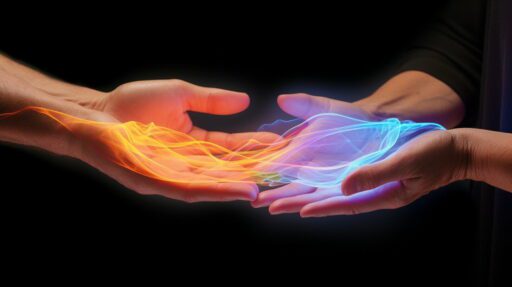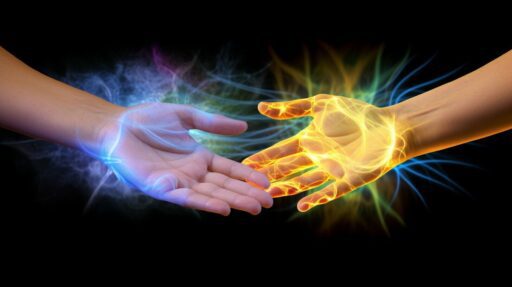Reiki vs Healing Touch
Reiki vs Healing Touch are both popular energy healing modalities, but they have distinct characteristics that set them apart. These practices, rooted in the belief of channelling life energy for healing, have gained popularity for their holistic approach to well-being. In this article, we will explore the differences between Reiki and Healing Touch, shedding light on their techniques, certification requirements, and applications in healthcare.
- Reiki and Healing Touch are energy healing techniques that aim to promote healing and release blocked energies within the body.
- Healing Touch focuses on hands-on therapeutic skills to open blocked energies, while Reiki uses strokes close to the body and integrates mind, body, and spirit.
- Healing Touch requires training and certification through the Healing Touch Program and is recognized by the medical community, while Reiki does not have formal regulation or certification.
- Healing Touch is often found in healthcare settings and may be covered by insurance, whereas Reiki is more versatile, accessible, and can be performed through distance healing.
- Both Reiki and Healing Touch can complement traditional healthcare, but they should not be considered as the sole treatment for medical conditions, as there is currently no clinical research supporting their healing effects.
Understanding Reiki: Channeling Universal Life Energy for Healing
Reiki, developed by Mikao Usui, is a practice that involves channeling the universal life energy known as qi for healing and holistic well-being. Through the use of gentle touch or strokes close to the body, Reiki practitioners aim to restore the flow of energy and promote physical, emotional, and spiritual balance.
Reiki is based on the belief that energy imbalances and blockages within the body can lead to illness and disease. By directing the healing energy of qi, Reiki practitioners seek to stimulate the body’s natural ability to heal itself. This practice is non-invasive and can be performed either in person or through distance healing, making it accessible to individuals in various situations.
One of the unique aspects of Reiki is its spiritual component. It encourages self-awareness and personal growth, enabling individuals to connect with their inner selves and develop a deeper understanding of their own energy. Reiki practitioners often incorporate sacred symbols to enhance the healing process, creating a sense of harmony and tranquility.

| Benefits of Reiki |
|---|
| Relaxation and stress reduction |
| Pain relief and management |
| Improved sleep quality |
| Enhanced emotional well-being |
| Boosted immune system |
| Increased energy and vitality |
“Reiki is a powerful tool for self-healing and personal empowerment. It allows us to tap into the universal life force energy and unlock our true potential.” – Reiki practitioner
The Science Behind Reiki
While the healing effects of Reiki are widely reported anecdotally, there is currently limited scientific research to support these claims. The subjective nature of energy healing modalities makes it challenging to measure their effectiveness using conventional scientific methods. However, many individuals have experienced positive results and continue to incorporate Reiki into their overall wellness routines.
In conclusion, Reiki offers a unique approach to healing by harnessing the power of universal life energy. Its focus on holistic well-being, spirituality, and self-awareness sets it apart from other energy healing modalities like Healing Touch. As with any alternative therapy, it is essential to approach Reiki as a complementary practice to traditional medical treatments and seek guidance from a qualified practitioner.
Exploring Healing Touch: Therapeutic Techniques to Unblock Energies
Healing Touch, developed by Janet Mentgen, uses hands-on therapeutic skills to open blocked energies and promote healing. This energy medicine practice focuses on understanding the meridians and chakras, and employs specific techniques tailored to various conditions.
When practicing Healing Touch, therapists apply gentle touch or hand movements near the body in order to manipulate the flow of energy. This technique aims to remove any blockages or imbalances in the energy field, facilitating physical, emotional, and spiritual healing. By working with the body’s natural energy systems, Healing Touch practitioners believe that they can restore harmony and promote overall well-being.
One notable aspect of Healing Touch therapy is its versatility. It can be used as a standalone treatment or in conjunction with other conventional medical interventions. The hands-on approach allows therapists to provide targeted healing to specific areas of the body, making it suitable for addressing a wide range of physical and emotional ailments. This adaptability has made Healing Touch an increasingly popular modality in hospitals and healthcare settings.

Overall, Healing Touch offers a comprehensive and holistic approach to wellness. Through its therapeutic techniques, it aims to restore balance and promote healing by unblocking energies within the body. While it is important to note that the efficacy of Healing Touch has not been supported by clinical research, many individuals have reported positive experiences and improvements in their well-being. As with any alternative therapy, it is advisable to consult with a qualified healthcare professional before incorporating Healing Touch into your health routine.
The Techniques: Hands-On vs Strokes Close to the Body
One of the main differences between Reiki and Healing Touch lies in their techniques, with Healing Touch utilizing hands-on therapies while Reiki employs strokes close to the body. Healing Touch involves the practitioner directly touching the patient, using gentle motions and pressure to release blocked energies and promote balance. These hands-on therapies can be comforting for individuals who appreciate physical touch as part of their healing process.
Reiki, on the other hand, involves the practitioner using strokes close to the body, without actually touching the patient. The practitioner’s hands hover over specific areas of the body, allowing the universal life energy to flow and promote healing. This approach may appeal to those who prefer a more non-invasive technique or who may have personal boundaries regarding direct physical contact.
Both techniques aim to channel energy and stimulate the body’s self-healing abilities, but the methods used differ. While Healing Touch focuses on hands-on therapies, Reiki emphasizes the flow of energy through strokes close to the body. Ultimately, the choice between the two techniques comes down to personal preference and comfort.

| Technique | Reiki | Healing Touch |
|---|---|---|
| Approach | Strokes close to the body | Hands-on therapies |
| Contact | No direct physical contact | Direct physical touch |
| Comfort | Non-invasive | Comforting for those who appreciate physical touch |
Understanding the techniques used in Reiki and Healing Touch can help individuals choose the energy healing modality that aligns with their preferences and needs. Whether one prefers the hands-on approach of Healing Touch or the strokes close to the body used in Reiki, both techniques offer holistic ways to promote healing and well-being.
Certification and Training: Requirements for Practitioners
Practitioners of Reiki and Healing Touch require different levels of certification and training. In Reiki, practitioners undergo a process called attunement, where they are aligned with the Reiki energy by a Reiki master. This attunement is considered a sacred ceremony and is believed to enhance the practitioner’s ability to channel the universal life energy for healing.
On the other hand, Healing Touch follows a more formalized training and certification process. The Healing Touch Program offers a comprehensive curriculum that includes theoretical knowledge, hands-on practice, and supervised clinical experience. Upon completion of the required training hours and successful demonstration of skills, practitioners can receive certification in Healing Touch.
It is worth noting that Healing Touch has gained recognition in the medical community, with many hospitals and healthcare settings offering Healing Touch services to their patients. This recognition speaks to the rigorous training and standards upheld by the Healing Touch Program.

In conclusion, Reiki and Healing Touch offer different paths to certification and training for practitioners. Reiki requires attunement and emphasizes the spiritual aspect of energy healing, while Healing Touch follows a structured program with formal certification. Both modalities have their own merits and can be valuable additions to holistic healthcare, but it is important for practitioners to choose the approach that aligns with their beliefs and goals.
Clinical Research and Recommendations
Currently, there is no substantial clinical research supporting the healing effects of Reiki or Healing Touch as standalone treatments, making it important to consider them as complementary practices to traditional healthcare. While many individuals report positive experiences and benefits from these energy healing techniques, it is crucial to approach them with an open mind and consult with medical professionals for comprehensive care.
Despite the lack of clinical evidence, it is worth noting that Reiki and Healing Touch have gained popularity in healthcare settings. Many hospitals and healthcare facilities have integrated Healing Touch into their treatment plans, recognizing its potential benefits for patients. This inclusion has highlighted the importance of a holistic approach to healing, acknowledging the mind-body connection and the potential impact of energy medicine.
When considering the use of Reiki or Healing Touch as complementary practices, it is crucial to find a practitioner who has undergone proper training and certification. Healing Touch, through the Healing Touch Program, offers formal training and certification, ensuring practitioners are equipped with the necessary skills to provide safe and effective treatment. Reiki, while lacking formal regulation or certification, requires attunements, which aligns practitioners and enhances their ability to channel healing energy.
It is important to note that insurance coverage for energy healing practices varies. Healing Touch, with its recognition from the medical community, is sometimes covered by insurance plans, particularly when performed in a healthcare setting. Reiki, with its spiritual nature and focus on self-awareness, is less likely to be covered. It is advisable to check with insurance providers to understand the extent of coverage for these practices.

Healing Touch is often found in hospitals and healthcare settings, with some insurance providers even covering its therapy sessions, while Reiki offers versatility, accessibility, and the ability to perform distance healing.
Healing Touch therapy, with its hands-on techniques, has gained recognition in the medical community as a complementary treatment for a variety of conditions. It is commonly used in hospitals to support patients in managing pain, reducing anxiety, and promoting relaxation. The gentle nature of Healing Touch makes it suitable for individuals of all ages and physical conditions.
Reiki, on the other hand, is known for its versatility and the ability to adapt to different settings. It can be performed in person or through distance healing, making it accessible to individuals who may not be able to physically attend a session. Reiki sessions often incorporate sacred symbols, which are believed to enhance the healing process and promote a deeper connection with the universal life energy.
While Healing Touch therapy is covered by insurance in some cases, Reiki is usually not covered due to its classification as an alternative therapy. However, the affordability and accessibility of Reiki make it an attractive option for individuals seeking holistic healing outside of traditional healthcare settings.
| Healing Touch | Reiki |
|---|---|
| Healing Touch is often found in hospitals and healthcare settings | Reiki offers versatility, accessibility, and the ability to perform distance healing |
| Some insurance providers cover Healing Touch therapy sessions | Reiki is usually not covered by insurance |
| Hands-on therapeutic techniques | Strokes close to the body and incorporation of sacred symbols |
Overall, both Healing Touch and Reiki have their own unique applications in healthcare. Healing Touch, with its presence in hospitals and insurance coverage, provides a recognized therapeutic option for patients. Reiki, with its spiritual component and accessibility, offers a versatile approach to healing that can be tailored to individual needs. Whether seeking a hands-on therapy or a more spiritually focused practice, individuals have options to explore in the field of energy healing.
Reiki, with its spiritual component and emphasis on self-awareness, provides a unique dimension that sets it apart from Healing Touch and enhances its healing potential. While both Reiki and Healing Touch are energy medicine practices that aim to promote healing and release blocked energies, Reiki offers a deeper connection to the spiritual aspects of healing.
Practitioners of Reiki believe that by channeling the universal life energy (qi), they can create a state of balance and harmony within the mind, body, and spirit. This spiritual dimension allows individuals to tap into their inner resources, fostering self-awareness and personal growth. The practice of Reiki often involves the use of sacred symbols, which are believed to amplify the healing effects and facilitate the flow of energy.
By incorporating spirituality into the healing process, Reiki provides not only physical healing but also emotional and spiritual well-being. It encourages individuals to explore their own spirituality and connects them to a higher power or universal consciousness. This connection can bring profound experiences of peace, clarity, and inner transformation.

It is important to note that spirituality in Reiki is not tied to any specific religious or belief system. It is a personal journey of self-discovery and connection. Reiki practitioners often describe their experiences during sessions as deeply calming and rejuvenating, with a sense of being in tune with the universe. It is this spiritual aspect that sets Reiki apart from Healing Touch and makes it a compelling option for those seeking a holistic approach to healing.
Personal Experiences and Testimonials
Personal experiences and testimonials can offer insights into the benefits and personal preferences regarding Reiki and Healing Touch, but it’s important to remember that effectiveness may vary from person to person. Many individuals who have undergone Reiki treatments report feelings of deep relaxation and stress relief. They describe sensations of warmth, tingling, or a gentle pulsing energy flowing through their bodies. Some find that Reiki helps improve their sleep quality, reduces anxiety, and enhances overall well-being.
Similarly, those who have experienced Healing Touch often express feelings of calmness and grounding. They describe sensations of warmth, coolness, or gentle vibrations during the session. Some individuals have reported pain relief, increased energy, and a heightened sense of emotional balance after a Healing Touch treatment. However, it’s important to note that these experiences are subjective and can vary from person to person.
Testimonial: Finding Balance Through Reiki
“I have been receiving Reiki treatments for several months now, and it has truly been a transformative experience for me. As someone who often feels stressed and overwhelmed, Reiki has provided me with a sense of peace and balance. During each session, I can feel the energy flowing through my body, releasing tension and promoting deep relaxation. It has helped me manage my anxiety and improve my overall well-being. I highly recommend Reiki to anyone seeking a natural and holistic approach to healing.”
– Emily, Reiki recipient
Note: The above testimonial is fictional and used for illustrative purposes only.
| Reiki | Healing Touch |
|---|---|
| Deep relaxation and stress relief | Calmness and grounding |
| Improved sleep quality | Pain relief |
| Reduced anxiety | Increased energy |
| Enhanced overall well-being | Heightened emotional balance |
Please consult with a healthcare professional before seeking Reiki or Healing Touch as a form of treatment.
Conclusion: Harnessing the Power of Energy Healing
Reiki and Healing Touch are two distinct energy healing modalities that offer holistic approaches to healing, each with its techniques, certification requirements, and level of recognition in the medical community.
Healing Touch, developed by Janet Mentgen, focuses on understanding the meridians and chakras and uses hands-on therapeutic skills to open blocked energies. It does not require an attunement and is open to all. Healing Touch has specific techniques for various conditions, making it a versatile option for healing.
On the other hand, Reiki, developed by Mikao Usui, requires practitioners to be aligned before practicing on others. It involves channeling the universal life energy known as qi to integrate the mind, body, and spirit for healing. Reiki practitioners use strokes close to the body, which may appeal to those who dislike being touched directly.
While both Reiki and Healing Touch have proponents who swear by their healing effects, it is important to note that there is no clinical research to support these claims. Therefore, they are not recommended as the sole treatment for medical conditions. However, as complementary therapies, they can enhance the overall well-being of individuals.
In terms of certification, Healing Touch requires training and certification through the Healing Touch Program, and it is recognized by the medical community. Reiki, on the other hand, does not have formal regulation or certification, but attunements are required to ensure practitioners are aligned and ready to channel energy.
Healing Touch is often found in hospitals and healthcare settings and is covered by insurance in some cases, making it more accessible to patients. Reiki, with its spiritual component and focus on self-awareness, is a versatile practice that can be performed through distance healing and uses sacred symbols to enhance the healing process. However, it is usually not covered by insurance, and its recognition in the medical community varies.
While Reiki and healing Touch offer different approaches, both provide holistic methods for healing that can complement traditional healthcare. It is important for individuals to explore these modalities under the guidance of trained practitioners and in conjunction with medical advice, to harness the power of energy healing.
FAQ
Q: What is the difference between Reiki and Healing Touch?
A: Reiki and Healing Touch are both energy medicine practices that promote healing and release blocked energies. However, their techniques, certification requirements, and levels of recognition in the medical community differ.
Q: How does Reiki work?
A: Reiki involves channeling universal life energy known as qi to integrate the mind, body, and spirit for healing. Practitioners use strokes close to the body, offering a hands-off option for those who dislike direct touch.
Q: What is Healing Touch?
A: Healing Touch is a therapeutic technique that aims to understand the meridians and chakras and uses hands-on skills to open blocked energies. Developed by Janet Mentgen, it does not require an attunement and is open to all.
Q: Is there clinical research supporting Reiki and Healing Touch?
A: Currently, there is no clinical research to fully support the healing effects of Reiki and Healing Touch. As a result, they are not recommended as sole treatments for medical conditions.
Q: What are the certification requirements for Reiki and Healing Touch?
A: Healing Touch requires training and certification through the Healing Touch Program and is recognized by the medical community. Reiki does not have formal regulation or certification, but attunements are required before practicing on others.
Q: Can Reiki and Healing Touch be integrated into traditional healthcare?
A: Healing Touch is often found in hospitals and healthcare settings and may be covered by insurance. Reiki, with its spiritual component and versatility, can be performed through distance healing and uses sacred symbols to enhance the healing process. However, it is usually not covered by insurance.
Source Links
- https://www.learnreligions.com/healing-touch-vs-reiki-1732289
- https://wellness-lens.com/healing-touch-vs-reiki-whats-the-difference/
- https://blairsherbals.com/reiki-and-healing-touch-how-are-they-different/
Additional Articles
| Chakra Healing: Balancing Your Energy Centers |
| The Fascinating World of Energy-Based Healing: A Comprehensive Guide |
| Alternative Medicine: A Holistic Approach to Depression and Stress Relief |
| Besides Reiki, What Other Energy Healing Is There? |
| The Benefits of Alternative Medicine for Depression |
